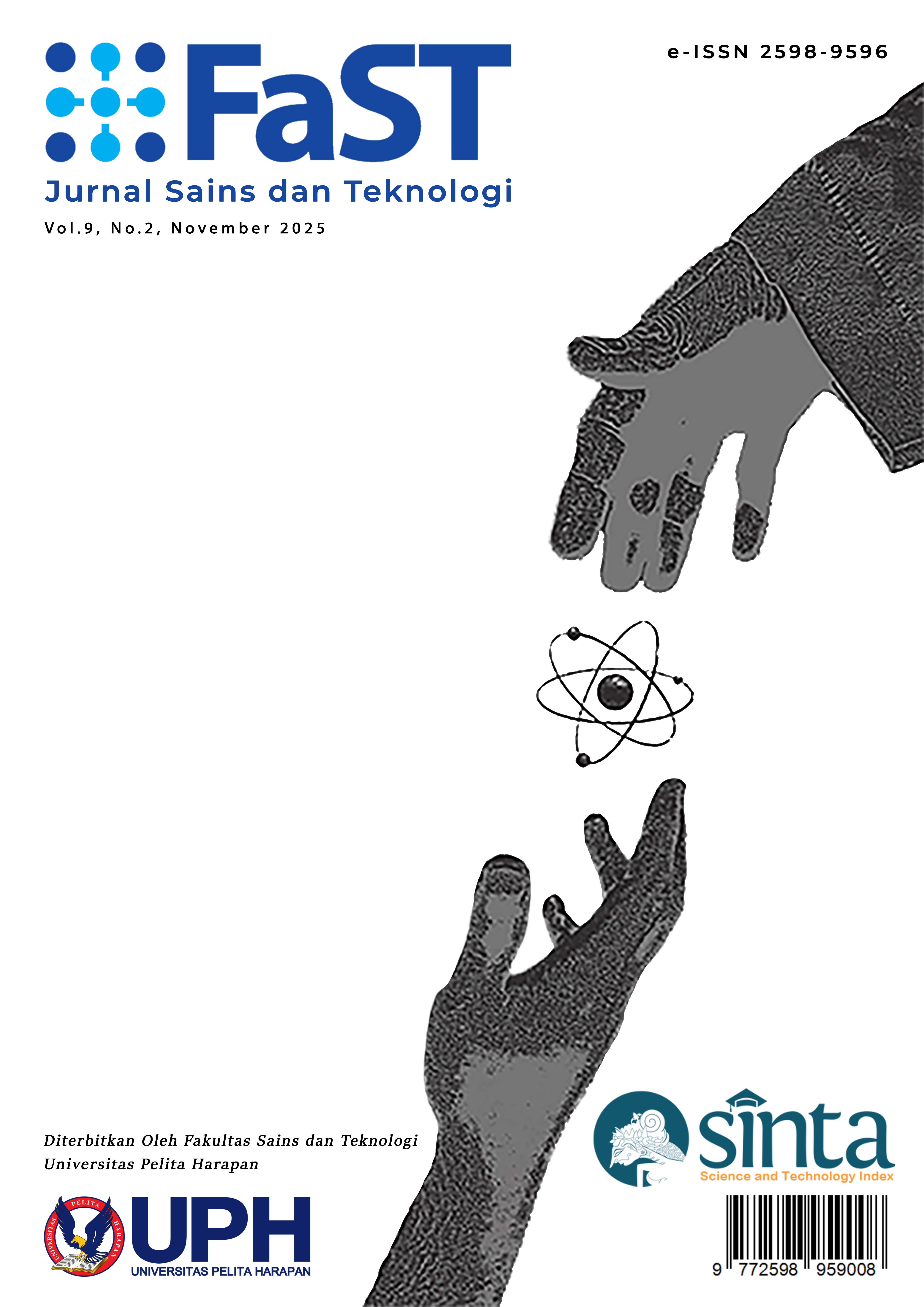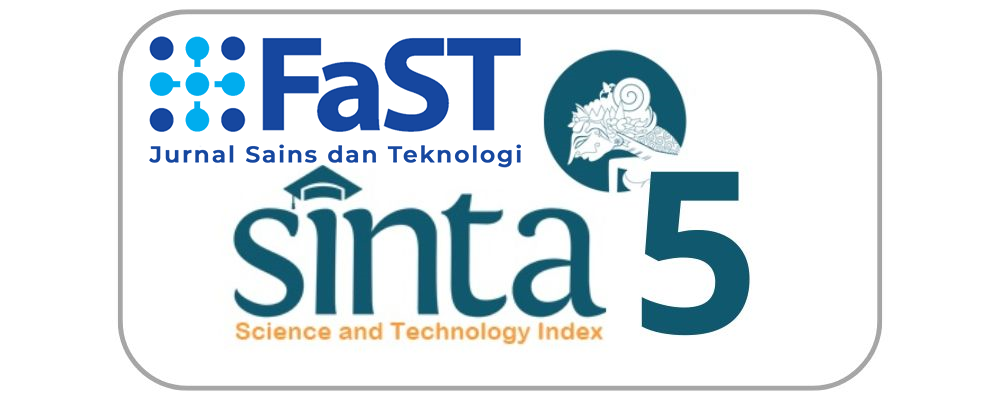Fermentation Using Providencia stuartii and Salmonella enterica to Produce N-Acetylglucosamine from Shrimp Shells’ Chitin
DOI:
https://doi.org/10.19166/jstfast.v9i2.10385Keywords:
colloidal chitin, combined fermentation, microbial, N-acetylglucosamine, shrimp shellsAbstract
Chitin is a biopolymer that can be extracted from exoskeleton of shrimp shells and other arthropods. One of its derivatives is N-acetylglucosamine that is comprised of glucose and amino acid glutamine. N-acetylglucosamine is known for its health effect, particularly in the treatment of osteoarthritis symptoms. One of the methods to produce N-acetylglucosamine is by fermentation using chitinolytic microorganisms. The aim of this research was to determine the optimum condition (pH, ratio of bacteria, fermentation time, and temperature) for fermentation using the combination of Providencia stuartii and Salmonella enterica to produce N-acetylglucosamine. The research was conducted at different pH (5, 6, 7, 8, 9) and bacterial ratios (3:1, 1:1 and 1:3). Furthermore, the optimum incubation temperature (30, 37, 40oC) and fermentation time (1, 2, 3 and 4 days) were also evaluated. The results showed the optimum condition was achieved at pH 8 with bacterial ratio of 1:1, incubated at 37oC for 3 days. Under these conditions, N-acetylglucosamine concentration obtained was 87,707.04 ± 906.54 ppm.
References
Agrawal, T., & Kotasthane, A. S. (2012). Chitinolytic assay of indigenous Trichoderma isolates collected from different geographical locations of Chhattisgarh in Central India. Springerplus, 1(1): 65-73. https://doi.org/10.1186/2193-1801-1-73
Aiba, S. (2009). Chemical and enzymatic modification of chitin and chitosan towards functional materials. In Lambertus A. M., van den Broek, C., & Boeriu, G. (Eds). Chitin and Chitosan: Properties and Applications (pp. 1-18). Institute for Biological Resources and Functions.
Alabaraoye, E., Achilonu, M., & Hester, R. (2017). Biopolymer (chitin) from various marine seashell wastes: isolation and characterization. Journal Polymer Environment, 26(7), 120-132. https://doi.org/10.1007/s10924-017-1118-y
Amalia, R., Rejeki, S., Widowati, L. L., & Ariyati, R. W. (2022). The growth of tiger shrimp (Penaeus monodon) and its dynamics of water quality in integrated culture. Biodiversitas, 23(1), 593-600. https://doi.org/10.13057/biodiv/d230164
AOAC. 2005. Official Methods of Analysis. The Association of Official Analytical Chemists, Gaithersburg.
Arbia, W., Arbia, L., Adour, L., & A. Amrane, A. (2012). Chitin extraction from crustacean shells using biological methods – a review. Food Technology Biotechnology, 51(1), 12-25.
Ayangbenro, A. S. (2017). Biodegradation of natural bitumen by Providencia stuartii isolated from heavy oil contaminated soil. Global NEST Journal, 19(2), 353-358. https://doi.org/10.30955/gnj.002148
Badan Pusat Statistik (BPS). (2018). Statistik Perusahaan Perikanan 2017. Retrieved May 5, 2019 from https://www.bps.go.id/publication/2018/10/22/78d5e2542ad793f3fbe4ecc 1/statistik-perusahaan-perikanan-2017.htm
Benhabiles, M. S., Salah, R., Lounici, H., Drouiche, N., Goosen, M. F. A., & and Mameri, N. (2012). Antibacterial activity of chitin, chitosan and its oligomers prepared from shrimp shell waste. Food hydrocolloids, 29(1), 48-56. https://doi.org/10.1016/j.foodhyd.2012.02.013
Cleo, T. P., Vilela, J., & Airoldi, C. (2014). The effect of chitin alkaline deacetylation at different condition on particle properties. Procedia Chemistry, 9, 220-225. https://doi.org/10.1016/j.proche.2014.05.026
Dompeipen, E. J., Kaimudin, M., & Dewa, R. P. (2016). Isolasi kitin dan kitosan dari limbah kulit udang. Majalah Biam, 12(1), 32-38.
Frederiksen, R. F., Paspaliari, D. K., Larsen, T., Storgaard, B. G., Larsen, M. H., Ingmer, H.. Palcic, M. M., & Leisner, J. J. (2013). Bacterial chitinases and chitin-binding proteins as virulence factors. Microbiology, 159, 833-847. https://doi.org/10.1099/mic.0.051839-0
Halim, Y., Hardoko, & Christy, A. (2018). Optimum conditions for N-acetyl glucosamine production from Penaeus monodon shrimp shells by solid state fermentation using Trichoderma virens. Asian Journal of Microbiology, Biotechnology, and Environmental Sciences, 20(4), 1081-1088.
Halim, Y., Tantradjaja, S. F., Hardoko, & Handayani, R. (2021). Immobilization of Providencia stuartii cells in papaya trunk wood for N-acetylglucosamine production from Pennaeus vannamei shrimp shells. Jurnal Ilmiah Perikanan dan Kelautan, 13(2), 208-221. http://doi.org/10.20473/jipk.v13i2.28011
Halim, Y., Handayani, R., Ayu, N., Lamtoro, S. T., & Hardoko. (2023). Penentuan kondisi fermentasi dalam produksi N-asetilglukosamin dari kulit udang menggunakan bakteri Providencia stuartii. Jurnal Sains dan Teknologi Pangan, 8(5), 6604-6617.
Hardoko, Josephine, C., Handayani, R., & Halim, Y. (2020). Isolation, identification and chitinolytic index of bacteria from rotten Tiger shrimp (Penaeus monodon) shells. AACL Bioflux, 13(1), 360-371.
Hossain, M. S., & Iqbal, A. (2014). Production and characterization of chitosan from shrimp waste. Journal Bangladesh Agriculture University, 1(12), 153-160. https://doi.org/10.3329/jbau.v12i1.21405
Hudson, J. A., Olsen, L., & Cook, R. (2011). Maximum Growth Temperatures of foodbourne pathogens and appropriate temperatures for hot holding. Publications Logistics Officer, Wellington.
Isa, M. T., Ameh, A. O., Gabriel, J. O., &Adama, K. K. (2012). Extraction and characterization of chitin from Nigerian sources. Leonardo Electronic Journal of Practices and Technologies, 21, 73-81.
Islam, S. Z., Khan, M. & Noswad, A. K. M. A. (2016). Production of chitin and chitosan from shrimp shell wastes. Journal Bangladesh Agriculture University, 14(2), 253-259. https://doi.org/10.3329/jbau.v14i2.32701
Kaimudin, M., & Leounupun, M. F. (2016). Karakterisasi kitosan dari limbah udang dengan proses bleaching dan deasetilasi yang berbeda. Majalah Biam, 12(1), 1-7.
Keerthirathne, T. P., Ross, K., Fallowfield, H., & Whiley, H. (2016). A review of temperature, pH and other factors that influence the survival of Salmonella in mayonnaise and other raw egg. Pathogens, 5(63), 1-11. https://doi.org/10.3390/pathogens5040063
Khatib, M. E., Tran, Q. T., Nasrallah, C., Lopes, J., Bolla, J. M., Vivaudou, M., Pages, J. M, & Colletier, J. P. (2017). Providencia stuartii forms biofilms and floating communities of cells that display high resistance to environmental insults. PLOS One, 12(3), 1-17. https://doi.org/10.1371/journal.pone.0174213
Kurmasheva, N., Vorobiev, V., Sharipova, M., Efremova, T., & Mardanova, A. (2018). The potential virulence factors of Providencia stuartii: motility, adherence, and invasion. BioMed Research International, 2018, 1-8. https://doi.org/10.1155/2018/3589135
Liu, L., Liu, Y., Shin, H. D., Chen, R., Li, J., Du, G., & Chen, J. (2013). Microbial production of glucosamine and N-acetylglucosamine: advances and perspectives. Applied Microbial Biotechnology, 97(14), 6149-6158. https://doi.org/10.1007/s00253-013-4995-6
Marganof, P. (2003). Potensi limbah udang sebagai penyerap logam berat (timbal, kadmium dan tembaga) di perairan [Bachelor Thesis]. Institut Pertanian Bogor, Bogor, Indonesia.
Michelle, V. (2019). Production of nN-acetylglucosamine from chitin extracted from shrimp shells by fermentation using Salmonella enterica strain LT2 [Bachelor Thesis]. Universitas Pelita Harapan, Tangerang, Indonesia.
Nguyen, H. H., Yi, S. Y., Woubit, A., & Kim, M. (2016). A portable surface plasmon resonance biosensor for rapid detection of Salmonella typhimurium. Applied Science Converging Technology. 25(3): 61-65. https://doi.org/10.5757/ASCT.2016.25.3.61
Nielsen, S. 2009. Food Analysis. Springer, USA. https://doi.org/10.1007/978-1-4419-1478-1
Oscar, T. P. (2009). Predictive model for survival and growth of Salmonella Typhimurium DT104 on chicken skin during temperature abuse. Journal of Food Protection, 72(2), 304-314. https://doi.org/10.4315/0362-028X-72.2.304
Pan, S., Wu, S., & Kim, J. (2011). Preparation of glucosamine by hydrolysis of chitosan with commercial α-amylase and glucoamylase. Journal of Zhejiang University, 12(11), 931-934. https://doi.org/10.1631/jzus.B1100065
Podolak, R., Enache, E., Stone, W., Black, D. G., & Elliott, P. H. (2010). Sources and risk factors for contamination, survival, persistence and heat resistance of Salmonella in low-moisture foods. Journal of Food Protection, 73(10), 1919-1936. https://doi.org/10.4315/0362-028X-73.10.1919
Rahmawati, W., Dian, H., & Husniati. (2012). Produksi kitosan dari bahan baku cangkang udang menggunakan metode kimia dan enzimatis dengan enzim kitin deasetilase [Bachelor Thesis]. Universitas Lampung, Lampung, Indonesia.
Rychlik, I., Martin, G., Methner, U., Lovell, M., Cardova, L., Sebkova, A., Sevcik, M., Damborsky, J., & Barrow, P. A. (2002). Identification of Salmonella enterica serovar typhimurium genes suppression in stationary-phase nutrient broth cultures and in the chicken intestines. Archives of Microbiology, 178(6), 411-420. https://doi.org/10.1007/s00203-002-0458-7
Sanusi, M. (2004). Transformasi kitin dari hasil isolasi limbah industri udang beku menjadi chitosan. Marina Chimica Acta, 5(2), 28-32.
Saskiawan, I., & Handayani, R. (2011). Production of N-acetyl-D-glucosamine by submerged fermentation from chitin. Berita Biology, 6, 20-28.
Setia, I. N. (2015). Chitinolytic assay and identification of bacteria isolated from shrimp waste based on 16S rDNA sequences. Advances in Microbiology, 5, 541-548. http://dx.doi.org/10.4236/aim.2015.57056
Sillanpaa, M., & Ncibbi, C. (2017). A sustainable bioeconomy: the green industrial revolution. Springer International Publishing, New York.
Steele, R. (2004). Understanding and measuring the shelf-life of food. Woodhead Publishing Limited, Florida. https://doi.org/10.1533/9781855739024
Tanaka, T., Fukui, T., & Imanaka, T. (2001). Different cleavage specificities of the dual catalytic domains in chitinase from the hyperthermophilic archaeon Thermococcus. Journal of Biological Chemistry, 276(38), 35629-35635. https://doi.org/10.1074/jbc.M105919200
Ulfa, M. (2016). Penentuan kadar glukosamin dari fermentasi kulit udang windu (Penaeus monodon) dengan metode hidrolisis dan pemanasan [Bachelor Thesis]. Universitas Lampung, Lampung, Indonesia.
Wang, W. P., Dua, Y. M., Qiu, Y. L., Wang, X. Y., & Hu, Y. J. (2008). A new green technology for direct production of low molecular weight chitosan. Carbohydrate Polymers, 74(1), 127-132. http://dx.doi.org/10.1016/j.carbpol.2008.01.025
Wanichpongpan, P., & Attasat, S. (2016). Optimum conditions for preparation of glucosamine hydrochloride and glucosamine sulfate from shrimp-shell chitin. International Journal of Applied Science and Technology, 6(2), 24-29.
Younes I., & Rinaudo, M. (2014). Chitin and chitosan preparation from marine sources. Structure, Properties and Application Marine Drugs, 13(3), 1133-1174. https://doi.org/10.3390/md13031133
Downloads
Published
Issue
Section
License
Copyright (c) 2025 Yuniwaty Halim, Nabilah binti Chanan Din, Lucia C. Soedirga

This work is licensed under a Creative Commons Attribution-ShareAlike 4.0 International License.
“Authors who publish with this journal agree to the following terms:
1) Authors retain copyright and grant the journal right of first publication with the work simultaneously licensed under a Creative Commons Attribution License (CC-BY-SA 4.0) that allows others to share the work with an acknowledgement of the work's authorship and initial publication in this journal.
2) Authors are able to enter into separate, additional contractual arrangements for the non-exclusive distribution of the journal's published version of the work (e.g., post it to an institutional repository or publish it in a book), with an acknowledgement of its initial publication in this journal.
3) Authors are permitted and encouraged to post their work online (e.g., in institutional repositories or on their website). The final published PDF should be used and bibliographic details that credit the publication in this journal should be included.”



